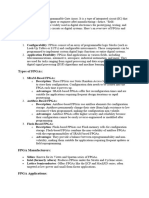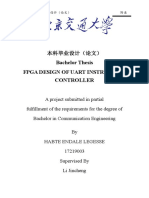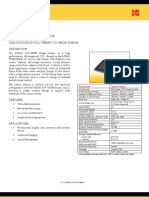Definition:: Field-Programmable Gate Array
Definition:: Field-Programmable Gate Array
Uploaded by
yaduyadavendraCopyright:
Available Formats
Definition:: Field-Programmable Gate Array
Definition:: Field-Programmable Gate Array
Uploaded by
yaduyadavendraOriginal Title
Copyright
Available Formats
Share this document
Did you find this document useful?
Is this content inappropriate?
Copyright:
Available Formats
Definition:: Field-Programmable Gate Array
Definition:: Field-Programmable Gate Array
Uploaded by
yaduyadavendraCopyright:
Available Formats
Field-programmable gate array Definition: A field-programmable gate array (FPGA) is an integrated circuit (IC) that can be programmed in the
field after manufacture. FPGAs are similar in principle to, but have vastly wider potential application than, programmable read-only memory (PROM) chips. FPGAs are used by engineers in the design of specialized ICs that can later be produced hard-wired in large quantities for distribution to computer manufacturers and end users. Ultimately, FPGAs might allow computer users to tailor microprocessors to meet their own individual needs.
Applications:
Applications of FPGAs include digital signal processing, software-defined radio, aerospace and defense systems, ASIC prototyping, medical imaging, computer vision, speech recognition, cryptography, bioinformatics, computer hardware emulation, radio astronomy, metal detection and a growing range of other areas. FPGAs originally began as competitors to CPLDs and competed in a similar space, that of glue logic for PCBs. As their size, capabilities, and speed increased, they began to take over larger and larger functions to the state where some are now marketed as full systems on chips (SoC). Particularly with the introduction of dedicated multipliers into FPGA architectures in the late 1990s, applications, which had traditionally been the sole reserve of DSPs, began to incorporate FPGAs instead. FPGAs especially find applications in any area or algorithm that can make use of the massive parallelism offered by their architecture. One such area is code breaking, in particular brute-force attack, of cryptographic algorithms. FPGAs are increasingly used in conventional high performance computing applications where computational kernels such as FFT or Convolution are performed on the FPGA instead of a microprocessor.
Design Entry There are different techniques for design entry. Schematic based, Hardware Description Language and combination of both etc. . Selection of a method depends on the design and designer. If the designer wants to deal more with Hardware, then Schematic entry is the better choice. When the design is complex or the designer thinks the design in an algorithmic way then HDL is the better choice. Language based entry is faster but lag in performance and density. HDLs represent a level of abstraction that can isolate the designers from the details of the hardware implementation. Schematic based entry gives designers much more visibility into the hardware. It is the better choice for those who are hardware oriented. Synthesis The process which translates VHDL or Verilog code into a device netlist formate. i.e a complete circuit with logical elements( gates, flip flops, etc) for the design. Synthesis process will check code syntax and analyze the hierarchy of the design which ensures that the design is optimized for the design architecture, the designer has selected. The resulting netlist(s) is saved to an NGC(Native Generic Circuit) file (for Xilinx Synthesis Technology (XST)).
Implementation This process consists a sequence of three steps 1. Translate 2. Map 3. Place and Route Translate process combines all the input netlists and constraints to a logic design file. This information is saved as a NGD (Native Generic Database) file. This can be done using NGD Build program. Here, defining constraints is nothing but, assigning the ports in the design to the physical elements (ex. pins, switches, buttons etc) of the targeted device and specifying time requirements of the design. Thisinformation is stored in a file named UCF (User Constraints File). Tools used to create or modify the UCF are PACE, Constraint Editor etc. Device Programming Now the design must be loaded on the FPGA. But the design must be converted to a format so that the FPGA can accept it. BITGEN program deals with the conversion. The routed NCD file is then given to the BITGEN program to generate a bit stream (a .BIT file) which can be used to configure the target FPGA device. This can be done using a cable. Selection of cable depends on the design. Design Verification Verification can be done at different stages of the process steps. Behavioral Simulation (RTL Simulation) This is first of all simulation steps; those are encountered throughout the hierarchy of the design flow. This simulation is performed before synthesis process to verify RTL (behavioral) code and to confirm that the design is functioning as intended. Behavioral simulation can be performed on either VHDL or Verilog designs. In this process, signals and variables are observed, procedures and functions are traced and breakpoints are set. This is a very fast simulation and so allows the designer to change the HDL code if the required functionality is not met with in a short time period. Since the design is not yet synthesized to gate level, timing and resource usage properties are still unknown. Functional simulation (Post Translate Simulation) Functional simulation gives information about the logic operation of the circuit. Designer can verify the functionality of the design using this process after the Translate process. If the functionality is not as expected, then the designer has to made changes in the code and again follow the design flow steps. Static Timing Analysis This can be done after MAP or PAR processes Post MAP timing report lists signal path delays of the design derived from the design logic. Post Place and Route timing report incorporates timing delay information to provide a comprehensive timing summary of the design.
Complex Programmable Logic Devices Complex programmable logic devices (CPLDs) are integrated circuits (ICs) or chips that application designers configure to implement digital hardware such as mobile phones. CPLDs can handle significantly larger designs than simple programmable logic devices (SPLDs), but provide less logic than field programmable gate arrays (FPGAs). CPLDs contain several logic blocks, each of which includes eight to 16 macrocells. Because each logic block performs a specific function, all of the macrocells within a logic block are fully connected. Depending upon the application, however, logic blocks may or may not be connected to one another.
Features in common with PALs:
Non-volatile configuration memory. Unlike many FPGAs, an external configuration ROM isn't required, and the CPLD can function immediately on system start-up. For many legacy CPLD devices, routing constrains most logic blocks to have input and output signals connected to external pins, reducing opportunities for internal state storage and deeply layered logic. This is usually not a factor for larger CPLDs and newer CPLD product families.
Features in common with FPGAs:
Large number of gates available. CPLDs typically have the equivalent of thousands to tens of thousands of logic gates, allowing implementation of moderately complicated data processing devices. PALs typically have a few hundred gate equivalents at most, while FPGAs typically range from tens of thousands to several million. Some provisions for logic more flexible than sum-of-product expressions, including complicated feedback paths between macro cells, and specialized logic for implementing various commonly-used functions, such as integer arithmetic.
The most noticeable difference between a large CPLD and a small FPGA is the presence of on-chip nonvolatile memory in the CPLD. This distinction is rapidly becoming less relevant, as several of the latest FPGA products also offer models with embedded configuration memory. The characteristic of non-volatility makes the CPLD the device of choice in modern digital designs to perform 'boot loader' functions before handing over control to other devices not having this capability. A good example is where a CPLD is used to load configuration data for an FPGA from non-volatile memory. CPLDs were an evolutionary step from even smaller devices that preceded them, PLAs (first shipped by Signetics), and PALs. These in turn were preceded by standard logic products, that offered no programmability and were "programmed" by wiring several standard logic chips together.
History of VHDL
Summary of History:
1981
Initiated by US DoD to address hardware life-cycle crisis
1983-85 Development of baseline language by Intermetrics, IBM and TI 1986 1987 1987 1994 2000 2002 2007 2009 All rights transferred to IEEE Publication of IEEE Standard Mil Std 454 requires comprehensive VHDL descriptions to be delivered with ASICs Revised standard (named VHDL 1076-1993) Revised standard (named VHDL 1076 2000, Edition) Revised standard (named VHDL 1076-2002) VHDL Procedural Language Application Interface standard (VHDL 1076c-2007) Revised Standard (named VHDL 1076-2008)
Requirement: VHDL was originally developed at the behest of the US Department of Defense in order to document the behavior of the ASICs that supplier companies were including in equipment. That is to say, VHDL was developed as an alternative to huge, complex manuals which were subject to implementation-specific details. The idea of being able to simulate this documentation was so obviously attractive that logic simulators were developed that could read the VHDL files. The next step was the development of logic synthesis tools that read the VHDL, and output a definition of the physical implementation of the circuit. Modern synthesis tools can extract RAM, counter, and arithmetic blocks out of the code, and implement them according to what the user specifies. Thus, the same VHDL code could be synthesized differently for lowest area, lowest power consumption, highest clock speed, or other requirements. Standardization: VHDL borrows heavilyfrom the Ada programming language in both concepts (for example, the slice notation for indexing part of a one-dimensional array) and syntax. VHDL has constructs to handle the
parallelism inherent in hardware designs, but these constructs (processes) differ in syntax from the parallel constructs in Ada (tasks). Like Ada, VHDL is strongly typed and is not case sensitive. There are many features of VHDL which are not found in Ada, such as an extended set of Boolean operators including nand and nor, in order to directly represent operations which are common in hardware. VHDL also allows arrays to be indexed in either direction (ascending or descending) because both conventions are used in hardware, whereas Ada (like most programming languages) provides ascending indexing only. The reason for the similarity between the two languages is that the Department of Defense required as much of the syntax as possible to be based on Ada, in order to avoid re-inventing concepts that had already been thoroughly tested in the development of Ada. VHDL 1987: The initial version of VHDL, designed to IEEE standard 1076-1987, included a wide range of data types, including numerical (integer and real), logical (bit and boolean), character and time, plus arrays of bit called bit_vector and of character called string. A problem not solved by this edition, however, was "multi-valued logic", where a signal's drive strength (none, weak or strong) and unknown values are also considered. This required IEEE standard 1164, which defined the 9-value logic types: scalar std_ulogic and its vector version std_ulogic_vector. Second issue of VHDL: The second issue of IEEE 1076, in 1993, made the syntax more consistent, allowed more flexibility in naming, extended the character type to allow ISO-8859-1 printable characters, added the xnor operator, etc. Minor changes in the standard (2000 and 2002) added the idea of protected types (similar to the concept of class in C++) and removed some restrictions from port mapping rules. In addition to IEEE standard 1164, several child standards were introduced to extend functionality of the language. IEEE standard 1076.2 added better handling of real and complex data types. IEEE standard 1076.3 introduced signed and unsigned types to facilitate arithmetical operations on vectors. IEEE standard 1076.1 (known as VHDL-AMS) provided analog and mixed-signal circuit design extensions. Some other standards support wider use of VHDL, notably VITAL (VHDL Initiative Towards ASIC Libraries) and microwave circuit design extensions.
You might also like
- Electronics For Electricians 7th Edition Herman Solutions ManualDocument13 pagesElectronics For Electricians 7th Edition Herman Solutions Manuallaurenstarkntmkfdjrqz100% (13)
- Complex Programmable Logic DeviceDocument7 pagesComplex Programmable Logic DeviceShaik BasheeraNo ratings yet
- Gigabyte GA-Z68X-UD3-B3 Rev 1.02 СхемаDocument42 pagesGigabyte GA-Z68X-UD3-B3 Rev 1.02 СхемаАндрей ОльховикNo ratings yet
- 8 Bit ALU by XilinxDocument16 pages8 Bit ALU by XilinxDIPTANU MAJUMDERNo ratings yet
- Master Thesis FpgaDocument5 pagesMaster Thesis Fpgatashahollowaylittlerock100% (1)
- What Is An FPGA?: Figure 1: FPGA Block StructureDocument10 pagesWhat Is An FPGA?: Figure 1: FPGA Block Structureacer551100% (1)
- Fpga Viva QuestionDocument4 pagesFpga Viva QuestionManila MathurNo ratings yet
- Implementation of Serial Communication IP For Soc ApplicationsDocument4 pagesImplementation of Serial Communication IP For Soc ApplicationsInternational Journal of computational Engineering research (IJCER)No ratings yet
- InterconnectsDocument6 pagesInterconnectsachuu1987No ratings yet
- Digital Filters in Programmable Logic DevicesDocument13 pagesDigital Filters in Programmable Logic DevicesJoerg MenkeNo ratings yet
- FPGA and FPGAC (High Level Synthesise Tools)Document15 pagesFPGA and FPGAC (High Level Synthesise Tools)RUBEN DARIO TAMAYO BALLIVIANNo ratings yet
- FPGA Vs ASICDocument9 pagesFPGA Vs ASICKamleshNo ratings yet
- FPGADocument16 pagesFPGAManohar TmNo ratings yet
- VHDL NotesDocument40 pagesVHDL Notesangel_hunNo ratings yet
- FPGA and CPLDWhat Is The DifferenceDocument10 pagesFPGA and CPLDWhat Is The DifferencejackNo ratings yet
- Unit-1Document43 pagesUnit-1harirnair nairNo ratings yet
- Project Report On Traffic Signal System Using FPGADocument10 pagesProject Report On Traffic Signal System Using FPGAanuragdhar dwivediNo ratings yet
- Field-Programmable Gate ArrayDocument12 pagesField-Programmable Gate ArrayJef PerezNo ratings yet
- Bachelor Thesis Fpga Design of Uart Instruction ControllerDocument12 pagesBachelor Thesis Fpga Design of Uart Instruction ControllerendaleNo ratings yet
- Design of Embedded ProcessorsDocument80 pagesDesign of Embedded ProcessorsSayan Kumar KhanNo ratings yet
- Thesis Fpga ImplementationDocument6 pagesThesis Fpga Implementationjessicabriggsomaha100% (2)
- Unit I Embedded SystemDocument42 pagesUnit I Embedded Systemkarthick707No ratings yet
- FPGA Based Multi Core ProcessorDocument16 pagesFPGA Based Multi Core ProcessorvinayNo ratings yet
- Fpga TutorialDocument10 pagesFpga Tutorialgsavithri_4017No ratings yet
- FPGA Kitap BLMDocument30 pagesFPGA Kitap BLMchandasreebhargavNo ratings yet
- Fpga HardwareDocument32 pagesFpga HardwaremdlogicsolutionsNo ratings yet
- What Is An FPGA?Document4 pagesWhat Is An FPGA?SUNILPATRONo ratings yet
- A Brief Study of Reconfigurable Computation Systems With A Focus of FPGA Based DevicesDocument11 pagesA Brief Study of Reconfigurable Computation Systems With A Focus of FPGA Based DevicesMeToolNo ratings yet
- 8.programmable Asic Design SoftwareDocument21 pages8.programmable Asic Design Softwaresalinsweety50% (2)
- Embedded Systems Unit I Part A (2 Marks)Document47 pagesEmbedded Systems Unit I Part A (2 Marks)Vijaya KumarNo ratings yet
- How To Design Your Own FPGADocument8 pagesHow To Design Your Own FPGAjackNo ratings yet
- FPGA Design Flow: Page 1 of 5Document6 pagesFPGA Design Flow: Page 1 of 5PRAVEEN034No ratings yet
- FPGA Paper PDFDocument18 pagesFPGA Paper PDFDhayanandhNo ratings yet
- Field-Programmable Gate ..., The Free EncyclopediaDocument14 pagesField-Programmable Gate ..., The Free EncyclopediaSuneelkrishna RallabhandiNo ratings yet
- Make-SoCs-flexible-with-embedded-FPGADocument6 pagesMake-SoCs-flexible-with-embedded-FPGAALiftsNo ratings yet
- Fpga Design FlowDocument3 pagesFpga Design FlowShaik IliyasNo ratings yet
- Fundamental Logic DesignDocument55 pagesFundamental Logic DesignSenay MehariNo ratings yet
- Fpgas Are Programmable Semiconductor Devices That Are Based Around ADocument12 pagesFpgas Are Programmable Semiconductor Devices That Are Based Around AsaikrishnaNo ratings yet
- Design Methods: Verilog HDL VHDLDocument6 pagesDesign Methods: Verilog HDL VHDLNiranjan BeheraNo ratings yet
- Vlsi Design FlowDocument7 pagesVlsi Design FlowAster RevNo ratings yet
- Chameleon Chips Full ReportDocument40 pagesChameleon Chips Full Reporttejaswi_manthena05No ratings yet
- Field-Programmable Gate Array - Wikipedia, The Free EncyclopediaDocument12 pagesField-Programmable Gate Array - Wikipedia, The Free EncyclopediaMohammad SoltanmohammadiNo ratings yet
- Wa0025.Document7 pagesWa0025.ناصر مباركNo ratings yet
- FPGA-Based Advanced Real Traffic Light Controller SystemDocument89 pagesFPGA-Based Advanced Real Traffic Light Controller SystemAnil Mahankali100% (1)
- Jimaging 05 00016Document22 pagesJimaging 05 00016vn7196No ratings yet
- Multicore FPGA Paper - FINALDocument9 pagesMulticore FPGA Paper - FINALunicycle1234No ratings yet
- Fusion Engineering and Design: A. Rigoni, G. Manduchi, A. Luchetta, C. Taliercio, T. SchröderDocument4 pagesFusion Engineering and Design: A. Rigoni, G. Manduchi, A. Luchetta, C. Taliercio, T. Schröderdavid Villa SotomayorNo ratings yet
- Vlsi 11900322028 Simanta SahaDocument8 pagesVlsi 11900322028 Simanta Sahaprabird420No ratings yet
- An Introduction To How FPGA Programming WorksDocument12 pagesAn Introduction To How FPGA Programming WorksjackNo ratings yet
- Deming Chen: Chapter 38, Design Automation For Microelectronics, Springer Handbook of AutomationDocument15 pagesDeming Chen: Chapter 38, Design Automation For Microelectronics, Springer Handbook of AutomationanilariNo ratings yet
- Vlsi Minor Training ReportDocument16 pagesVlsi Minor Training ReportAditya KumarNo ratings yet
- Image Processing Using VHDLDocument36 pagesImage Processing Using VHDLthesjus raiNo ratings yet
- A Study of FPGA-based System-on-Chip DesignsDocument12 pagesA Study of FPGA-based System-on-Chip DesignsZ e u s V e n i f i c u sNo ratings yet
- FPGADocument34 pagesFPGATesfaye WoldemeskelNo ratings yet
- Fpga QuestionsDocument10 pagesFpga QuestionsSuji DarsanNo ratings yet
- The Features of RISC Architecture That Support Pipelining Are Listed in Table 1Document4 pagesThe Features of RISC Architecture That Support Pipelining Are Listed in Table 1balavinmailNo ratings yet
- How To Program, Architecture, and Applications of Lattice FPGADocument23 pagesHow To Program, Architecture, and Applications of Lattice FPGAjackNo ratings yet
- Arithmetic Logic Unit: Project Report OnDocument36 pagesArithmetic Logic Unit: Project Report OnYermakov Vadim IvanovichNo ratings yet
- FPGA Programming for Beginners: Bring your ideas to life by creating hardware designs and electronic circuits with SystemVerilogFrom EverandFPGA Programming for Beginners: Bring your ideas to life by creating hardware designs and electronic circuits with SystemVerilogNo ratings yet
- PLC: Programmable Logic Controller – Arktika.: EXPERIMENTAL PRODUCT BASED ON CPLD.From EverandPLC: Programmable Logic Controller – Arktika.: EXPERIMENTAL PRODUCT BASED ON CPLD.No ratings yet
- Embedded Software Design and Programming of Multiprocessor System-on-Chip: Simulink and System C Case StudiesFrom EverandEmbedded Software Design and Programming of Multiprocessor System-on-Chip: Simulink and System C Case StudiesNo ratings yet
- D C Motors Starter DesignDocument14 pagesD C Motors Starter DesignDnyanesh Gole0% (1)
- Solar Energy in Saudi ArabiaDocument3 pagesSolar Energy in Saudi ArabiaAli AlhaddadNo ratings yet
- Presentation On Transistors: Presented byDocument19 pagesPresentation On Transistors: Presented byMonith ElyonNo ratings yet
- CSS - 05-Week 4 - Module 4 - PPE & OHSDocument7 pagesCSS - 05-Week 4 - Module 4 - PPE & OHSElixa HernandezNo ratings yet
- Honeywell 6148 Install GuideDocument2 pagesHoneywell 6148 Install GuideAlarm Grid Home Security and Alarm MonitoringNo ratings yet
- Ademco Lynx - Installation and Setup GuideDocument72 pagesAdemco Lynx - Installation and Setup Guidedom1nanceNo ratings yet
- ECEN 4827/ 5827: Analog IC DesignDocument27 pagesECEN 4827/ 5827: Analog IC DesignIELTS 2021.10No ratings yet
- SDT170Document8 pagesSDT170Julio RicardoNo ratings yet
- SCM-W Datasheet v41Document10 pagesSCM-W Datasheet v41nguyenam2008No ratings yet
- DatasheetDocument15 pagesDatasheetscatmaNo ratings yet
- Reyrolle Trip Circuit Supervision Relay: Catalog Reyrolle 7PJ13 Edition 3Document18 pagesReyrolle Trip Circuit Supervision Relay: Catalog Reyrolle 7PJ13 Edition 3Arunava BasakNo ratings yet
- Motherboard Manual For Gigabyte GA-586TXDocument112 pagesMotherboard Manual For Gigabyte GA-586TXDinusha AmerasingheNo ratings yet
- HVAC Estimate TemplateDocument3 pagesHVAC Estimate TemplateJ BINo ratings yet
- Co 18cs34 Notes FinalDocument141 pagesCo 18cs34 Notes FinalAshishNo ratings yet
- Synchronous Motor PROJECTDocument9 pagesSynchronous Motor PROJECTMd Samee MNo ratings yet
- Switchesrelays 2020 Catalogue 160919Document172 pagesSwitchesrelays 2020 Catalogue 160919'viki Art100% (1)
- Data SheetDocument2 pagesData SheetMichael HurniNo ratings yet
- Designing and FPGA Implementation of IIRDocument6 pagesDesigning and FPGA Implementation of IIRsnri0da9No ratings yet
- PhysicsDocument5 pagesPhysicsAyo100% (1)
- Method Statement For Installation - Electric Pump MotorDocument5 pagesMethod Statement For Installation - Electric Pump MotorAldrige Tatenda Vengesai100% (1)
- Project 6th 2021Document5 pagesProject 6th 2021Sunny SinghNo ratings yet
- Performance Evaluation of Femtocell Analysis For Capacity and Throughput in Various Path Loss ModelsDocument4 pagesPerformance Evaluation of Femtocell Analysis For Capacity and Throughput in Various Path Loss ModelsInternational Journal of Innovative Science and Research TechnologyNo ratings yet
- TDMA Code ExplanationDocument7 pagesTDMA Code Explanationshukla224No ratings yet
- Manufacturing of Turbo Generators in BHELDocument8 pagesManufacturing of Turbo Generators in BHELPraveen Kumar100% (3)
- PT3 Pressure Transmitter: Technical DataDocument4 pagesPT3 Pressure Transmitter: Technical DataRahul VRNo ratings yet
- MBA Organisational Behaviour - Company AnalysisDocument13 pagesMBA Organisational Behaviour - Company AnalysisMohammad Faizal AbdullahNo ratings yet
- Bruce E. Depalma: N-Machine: Extraction of Electrical Energy Directly From Space: The N-MachineDocument7 pagesBruce E. Depalma: N-Machine: Extraction of Electrical Energy Directly From Space: The N-MachinebanzailoicNo ratings yet
- Chapter1 - The 8051Document16 pagesChapter1 - The 8051Aaron Lewis DinkinNo ratings yet

























































































